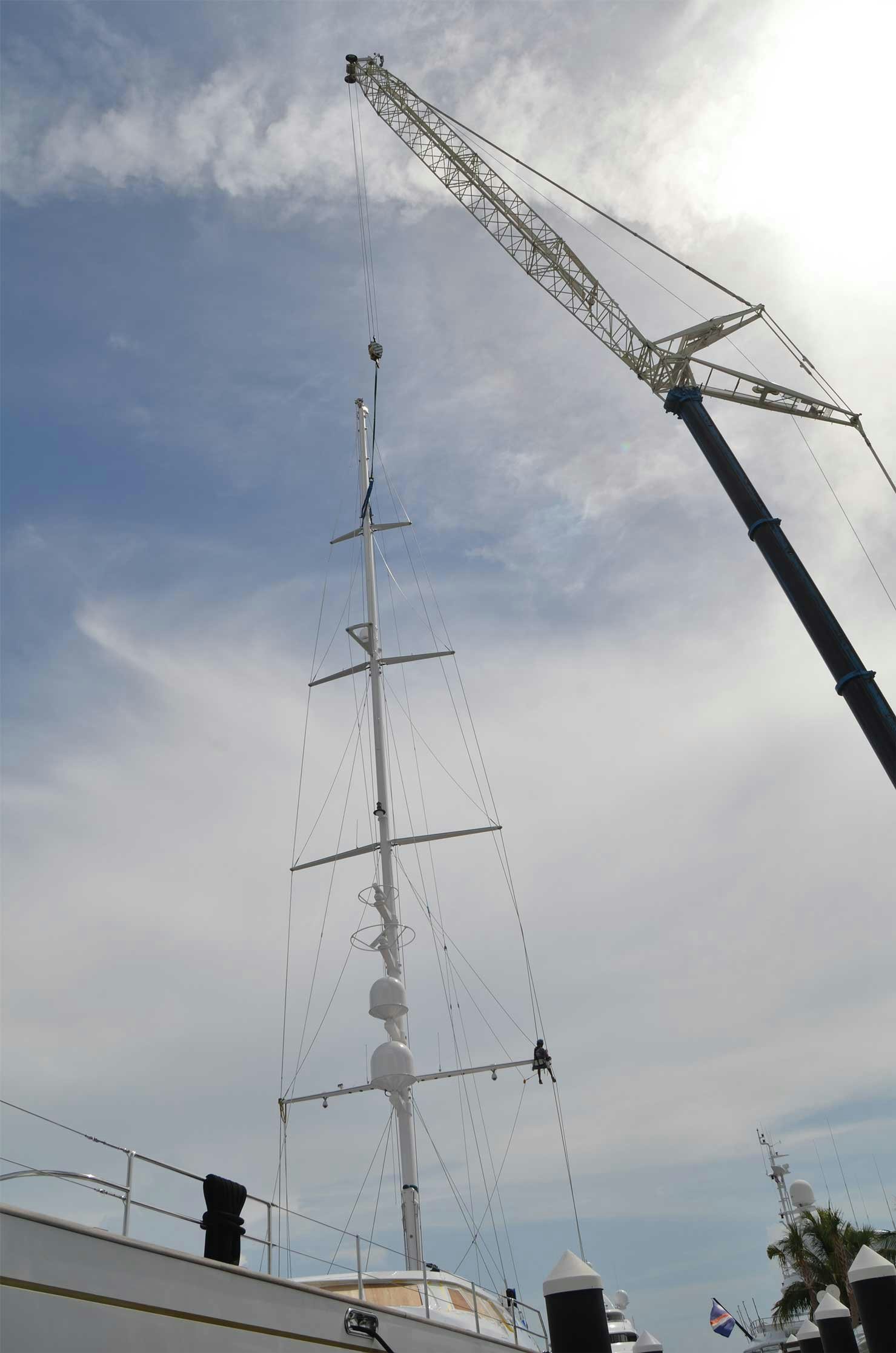64m Perini Navi S/Y FELICTA WEST Refit at Rybovich Superyacht Marina

Even with constant maintenance, every yacht eventually will need a refit. Often times, yacht refits are viewed as a painful and stressful experience for owner, captain, crew and sometimes the yard. But not all captains and yards are willing adhere to the age-old, traditional refit plan of “we’ll sort it out when we get there.”
One of the most detrimental mistakes during a refit, according to Edwards, is lack of planning. With a strong background in engineering and project management, Edwards knows what he’s talking about. FELICITA WEST, the stunning 64-meter Perini Navi built in 2003, was due for an extensive refit. Her rigging was 18 months overdue and the paint was in need of an update. Along with these assignments, the vessel also needed new monitoring and exhaust systems, an overhaul of the air conditioning and more.
With a limited amount of time, Edwards chose a yard that would make good on their negotiated time and price. Rybovich’s Vice President of Business Development Francois van Well for Rybovich breaks down its alternative and exceptional style. “Refits aren’t just something you can do without planning. You can’t take the boat out of the water and see what happens. But traditionally, that’s how a lot of refits have been done. By sheer numbers, we need to be able to schedule, allocate resources properly and so on. We have project managers for each individual refit,” he explains.

As far as planning goes, “I inherited, to some extent, a certain amount of this work scoped out,” says Edwards. “My predecessor had done quite a lot of reconnaissance during the last couple of years. When I came on to this project, I looked at the outline and went into detail with Rybovich as to specific dates and prices.”
When undergoing a refit at Rybovich, “The captain and owner put in the initial request, then we then give our interpretation,” explains van Well. “Then we run through it together. The captain and owner air concerns, and then we have a dialogue to adjust the expectations and re-quote. When you plan it well in advance, you can spend time working out all of those details before heading into the yard.”
Edwards also chose Rybovich because of its relationship with various outside contractors. “I have a very good working relationship with Tony Hawk of SeaHawke Rigging. As a sailboat captain, you must trust the person putting rigging together,” says Edwards. Rybovich prides itself not only on its employees, but also the outside vendors it chooses. “We have preferred contractors for pricing and insurance reasons — we need to be able to trust that they can do the work in the allotted time frame,” explains van Well.
Once the details have been finalized and the work has begun, even the most well-prepared captain, project manager and refit yard can stumble across unforeseen obstacles. “You always could run across challenges that you discover only in the dry-dock phase,” says Edwards. “But there’s nothing you can do about that until you get under the boat to poke and prod.”
Rybovich has a structure in place for dealing with newly discovered concerns. “At the beginning of a project, we look at the requested scope,” van Well clarifies. “We first set the must-do list, then the ‘would-be-nice’ list. Then there is what we call discovery, like mold or corrosion — things you would only discover after opening up the vessel. We have to budget into our schedule a percentage of growth. If something really big comes up, we discuss it as a team and we speak with the owner and captain. The benefit of a highly talented in-house team in all disciplines means we can assess the situation and come up with alternative solutions.”
When it comes down to it, refits are all about understanding more than just the scope, but also the smallest details, says van Well. “Our project management system is set up, so the managers really run the projects. The traditional mindset is that when you go to the yard, it’s going to be stressful and the captain can’t leave the boat for a minute. He has to be in charge of the project, all of the subcontractors, all of his own crew — that’s the old model. Now, the vessel arrives, the contract already has been signed, we go over it for two or three days then the captain can take his holiday and leave the yacht in the hands of the project manager, first mate or engineer. The captain will receive updates, with schedules, invoices, etc. so he can track it off site. This allows senior crew to take downtime when the vessel is in the yard.” While Edwards stayed on during the entire refit of FELICITA WEST, he worked hand-in-hand with project manager Chris Wright to ensure that the refit was seamless from drydock to mast maintenance and beyond.
There is so much that can go wrong during a refit, from bloated bottom lines to unfinished work, but both van Well and Edwards agree that understanding and planning are the keystones to the anatomy of a perfect refit. “Plan. Plan, plan, plan and plan again,” says Edwards “Do the homework before you go, because if you go in without a plan, you’re doomed from the start.”
Read Next